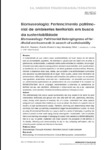Mostrar o rexistro simple do ítem
Biomuseologia: pertencimento patrimonial de ambientes territoriais em busca da sustentabilidade
| dc.contributor.author | Pedreira, Rita C.O. | |
| dc.contributor.author | Pereira, Eráclito | |
| dc.contributor.author | Wanderley Filha, Iracy | |
| dc.date.accessioned | 2019-03-21T10:03:13Z | |
| dc.date.available | 2019-03-21T10:03:13Z | |
| dc.date.issued | 2015 | |
| dc.identifier.citation | Ambientalmente Sustentable, 2015, 20: 1689-1698. ISSN: 1887-2417 | es_ES |
| dc.identifier.issn | 1887-2417 | |
| dc.identifier.uri | http://hdl.handle.net/2183/22308 | |
| dc.description.abstract | [Resumo] A compreensão de que cultura causa sustentabilidade, há muito deixou de ser latente para as comunidades populares. Os indivíduos e grupos que ora lidam com as artes, a gastronomia, as festividades, a oralidade, entres outras vertentes do cotidiano, de um lugar, entendem que estes aspectos salvaguardam e alicerçam suas tradições, tanto quanto atraem as tendências de um turismo específico e de ótima qualidade socioeconômica. Portanto, informar e disseminar estas lidas, diárias, que compõem uma territorialidade é primordial para alavancar as potencialidades de um lugar. Tanto quanto, utilizar como ferramenta de pertencimento a Educação Ambiental, está norteadora das ações em busca de um planeta mais igualitário. Justamente, tecer esta teia – multifacetada – de atividades que envolvem os conhecimentos-aprendizados de pertencimento de uma localidade é fio condutor da BIOMUSEOLOGIA, isto é: congregar, instrumentalizar e dinamizar, as perspectivas do território em seu viés identitário, informando e comunicando seu dia a dia, catalisando autoestima, como também, fomentando políticas públicas e finanças ao local. | es_ES |
| dc.description.abstract | [Abstract] The understanding that culture causes sustainability has long ceased to be latent for poor communities. Individuals and groups who now deal with the arts, gastronomy, festivities, orality, among other aspects of everyday life, of a place, understand that these aspects safeguard and underpin their traditions as much as attract the trends of a specific king of tourism, of high socioeconomic quality. Therefore, informing and disseminating these daily practices, that make up a territory, is essential to trigger the potentialities of a place. As much as using Environmental Education as a way to lead to a sense of belonging, is guiding the actions in pursuit of more world equity. Exactly weaving this - multifaceted - web of activities that involve learning-knowledge of belonging of a place is the backbone of BIOMUSEOLOGY, that is to say: to gather, implement and make dynamic the prospects of the territory in its identity, informing and communicating its day to day, catalyzing self-esteem, also by promoting public policies and finances to the place | es_ES |
| dc.language.iso | por | es_ES |
| dc.publisher | Universidade da Coruña, Servizo de Publicacións | es_ES |
| dc.rights | Atribución-CompartirIgual 3.0 España | es_ES |
| dc.rights.uri | http://creativecommons.org/licenses/by-sa/3.0/es/ | * |
| dc.subject | Biomuseologia | es_ES |
| dc.subject | Educação ambiental | es_ES |
| dc.subject | Patrimônio cultural | es_ES |
| dc.subject | Sustentabilidade | es_ES |
| dc.subject | Biomuseology | es_ES |
| dc.subject | Environmental education | es_ES |
| dc.subject | Environmental education | es_ES |
| dc.subject | Cultural belongingness | es_ES |
| dc.subject | Sustainability | es_ES |
| dc.title | Biomuseologia: pertencimento patrimonial de ambientes territoriais em busca da sustentabilidade | es_ES |
| dc.title.alternative | Biomuseology: patrimonial belongingness of territorial environments in search of sustainability | es_ES |
| dc.type | journal article | es_ES |
| dc.rights.accessRights | open access | es_ES |
| UDC.journalTitle | AmbientalMente Sustentable: Revista científica galego-lusófona de educación ambiental | es_ES |
| UDC.volume | 20 | es_ES |
| UDC.startPage | 1689 | es_ES |
| UDC.endPage | 1698 | es_ES |
| dc.identifier.doi | https://doi.org/10.17979/ams.2015.02.020.1693 | |
| UDC.coleccion | Publicacións UDC | es_ES |






